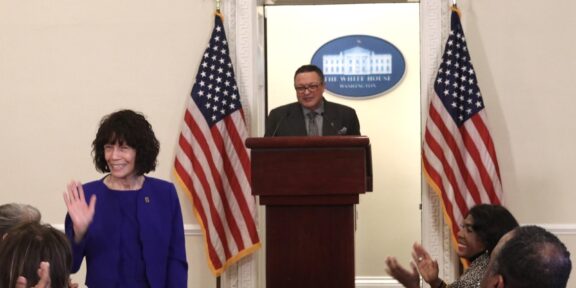For most people, when they hear the term “eating disorder”, the image of a young, middle class female comes to mind. But, health experts have recently reported that many black women suffer from eating disorders too.
In May, Empire star, Gabourey Sidibe divulged her battle with bulimia nervosa in her memoir, This is Just My Face: Try Not to Stare. During an interview with People magazine, Scandal star Kerry Washington also admitted to battling bulimia in college. Actress and singer, Brandy Norwood, also disclosed to People magazine that she struggled with an eating disorder as a teenager.
Although Sidibe, Washington, and Norwood disclosed their individual battles with eating disorders, most black women with eating disorders remain unnoticed, untreated and under represented in clinical studies about eating disorders. The under representation of black women in clinical studies pertaining to eating disorders perpetuates the idea that eating disorders are solely a European malady.
“The idea that any group is immune to eating disorders is a damaging one, because if a condition is not acknowledged and diagnosed, it will not be addressed, treated, and healed,” said Abiola Abrams.
Abrams is the award-winning author of The Sacred Bombshell Handbook of Self-Love, an ESSENCE advice columnist, and the founder of the empowerment site SacredBombshell.com. She recently wrote an expository Huffington Post article titled Black Women Don’t have Eating Disorders in which she discussed her personal battle with an eating disorder and aimed to prove that black women are not immune to eating disorders.
“A lot of black patients with symptoms of eating disorders go untreated because there is a stereotype that eating disorders are for white women,” said Dr. Lajoyce Brookshire, a naturopathic doctor and the author of the book, Faith Under Fire.
Brookshire was the Director of Publicity at Arista Records. She represented Aretha Franklin, Sean "Diddy" Combs, OutKast, 112, Deborah Cox, Whitney Houston, and The Notorious B.I.G. until his death. Brookshire was also a dancer and a model for twenty years.
“I worked with a lot of dancers,” Brookshire said, “Both black and white women in the entertainment industry used to binge eat and purge. In fact, there was a lot more pressure for black girls in the entertainment business to fit a European beauty standard.”
Brookshire said that a black girl introduced her to bulimia nervosa at her performing arts high school.
“We were dancers,” Dr. Brookshire said, “and I asked her how she ate so much, but managed to maintain her slim figure. Then she took me to the bathroom: ‘It’s not about how much you eat,’ she said. Then she held up two fingers, ‘it’s about this.’ And she proceeded to stick her fingers down her throat and vomit. I couldn’t bring myself to do it.”
Brookshire said that both anorexia nervosa and bulimia nervosa have onset ages in adolescence and “high school” for both white and black women.
“Anorexia and bulimia are mental illnesses that are connected to low self esteem,” Dr. Brookshire said, “These disorders have to do with not feeling good about yourself, or not feeling in control of yourself. A lot of women- of all races- feel as if their lives are out of control, so they try to control their food intake.”
Dr. Vincent Dowling, who has specialized in pediatric medicine for over 20 years agrees that eating disorders are prevalent amongst black women as well as white women.
“I definitely see anorexia nervosa, bulimia nervosa, and binge eating disorder in my black patients,” Dowling said “And I do see eating disorders more in black patients because I treat predominantly black patients.”
Dowling is an affiliate of the Jamaica Hospital Medical Center in Queens, NY, the Kings County Hospital Center in Brooklyn, NY, and the Brooklyn Hospital Center. Dr. Dowling treats primarily Black and Latino patients under the age of 18, but he has diagnosed and treated patients who are suffering from anorexia nervosa and bulimia nervosa.
The majority of Dr. Dowling’s patients are black and youth who live in underserved communities in Brooklyn and Queens. Dr. Dowling aims to educate his patients and their families about nutrition and overeating.
“I see a lot of obesity in black teens,” Dowling said. “A lot of overeating- especially in my female patients- can be attributed to binge eating disorder.”
Binge eating disorder (BED) is an eating disorder characterized by recurrent episodes of eating large quantities of food (often very quickly and to the point of discomfort); a feeling of a loss of control during the binge; experiencing shame, distress or guilt afterwards; and not regularly using unhealthy compensatory measures, such as purging, to counter the binge eating.
“A lot of young black women binge eat because it’s the norm for people in the community,” Dowling said, “It’s learned behavior. Children become conscious of their body image around 13 or 14, and that’s what triggers anorexia and bulimia- they’re mental illnesses that are caused by a distorted body image perception. But unlike anorexia and bulimia, binge eating disorder can also be attributed to societal norms and learned behavior.”
Dowling believes that black girls can inherit binge eating disorder from their mothers.
“A lot of black girls watch their mothers binge eat in order to cope with stress, and then they start to binge eat to cope with stress because that’s all they see,” Dowling said.
Dowling looks for eating disorders in his black patients because he feels that the black community often ignores the symptoms of mental illness.
“Eating disorders are not a white woman's illness,” Dowling said, “Eating disorders are a form of mental illness, and everyone is able to get mental illnesses. Doctors should start looking for eating disorders in black women more, because the black community tends to ignore the symptoms of mental illness until they become unbearable, and at that point treatment becomes a lot more difficult.”
The National Survey of American Life (NSAL) conducted a nationwide study of African Americans and Caribbean blacks to inquire about the prevalence of eating disorders in communities of color. Professionally trained examiners interviewed 5,191 adults and 1,170 adolescents in their homes in order to assess DSM-IV TR eating disorders.
The study conducted by the National Survey of American Life proved that that even though African Americans are at a lower risk for anorexia than their white counterparts, when they do get the disease, the age of onset is earlier (14.9 years versus 18.9 years) and the course of the disorder is longer.
The study also revealed that black women are more likely to develop bulimia nervosa than white women. Lifetime prevalence rates for bulimia in Black Americans is 1.5 percent for black adults, which is slightly higher than the national average of 1.0%.
The study conducted by the National Survey of American Life showed that binge eating disorder occurs at a higher frequency in black women than in white women. The study proved that black women suffer from binge eating disorder at higher rates than white women. 1.7 percent of the black women in the survey qualified for a lifetime prevalence of binge eating disorder, although 5.1 percent of black women had some problems with binge eating whether or not they met criteria for a disorder. Binge eating had the highest age of onset (22.8) in black women, which is similar to the general population.
Dr. Monnica T. Williams, a licensed clinical psychologist, analyzed the nationwide study in her article Guess Who’s coming to Dinner: Eating Disorders in African Americans, which was published by Psychology Today. Williams is also the director of the Center for Mental Health Disparities, and an associate professor in the Department of Psychological and Brain Sciences at the University of Louisville.
Dr. Williams said, “This older age of onset may reflect less of a concern for smaller body size and may represent more of a reaction to stress. Lower incomes and stress due to racism may have an effect on the drive to binge as a coping mechanism.
A study conducted by the University of Southern California showed that girls who are African-American are 50 percent more likely than girls who are white to be bulimic, and that girls from families in the lowest income bracket studied are 153 percent more likely to be bulimic than girls from the highest income bracket.
USC College economist Michelle Goeree, who conducted the study, concluded that “Girls with an eating disorder who are African-American or come from low-income families are much less likely to be diagnosed. Who goes to the hospital? Those who have insurance. Who tends to have insurance? Wealthier, better-educated people.”
The stereotype that black women don’t have eating disorders can also be attributed to the fact that black women are less likely to seek treatment for eating disorders because socio economic disparities.
Truth Be Told:
So is it true that black women don’t get eating disorders? No it’s not.
Dr. LaJoyce Brookshire and Dr. Vincent Dowling said that they saw eating disorders in black patients at the same rates that they saw eating disorders in white patients.
The National Survey of American Life found that while black women are less likely to suffer from anorexia nervosa, the national average for the lifetime prevalence of bulimia nervosa is 1.0%, but it is 1.5% in black women. The National Survey of American Life also found that black women are more likely than white women to develop binge eating disorder.
The University of Southern California also proved that black girls are 50% more likely than white girls to develop bulimia nervosa.




